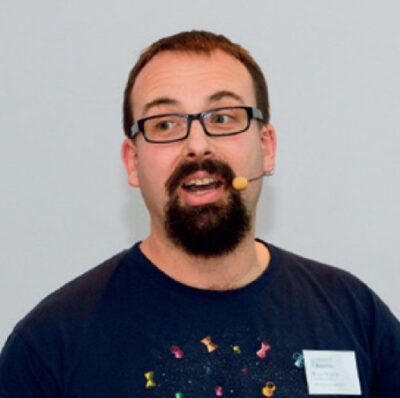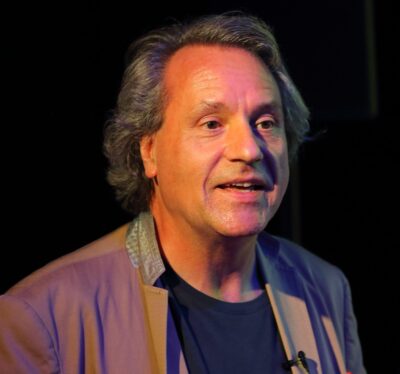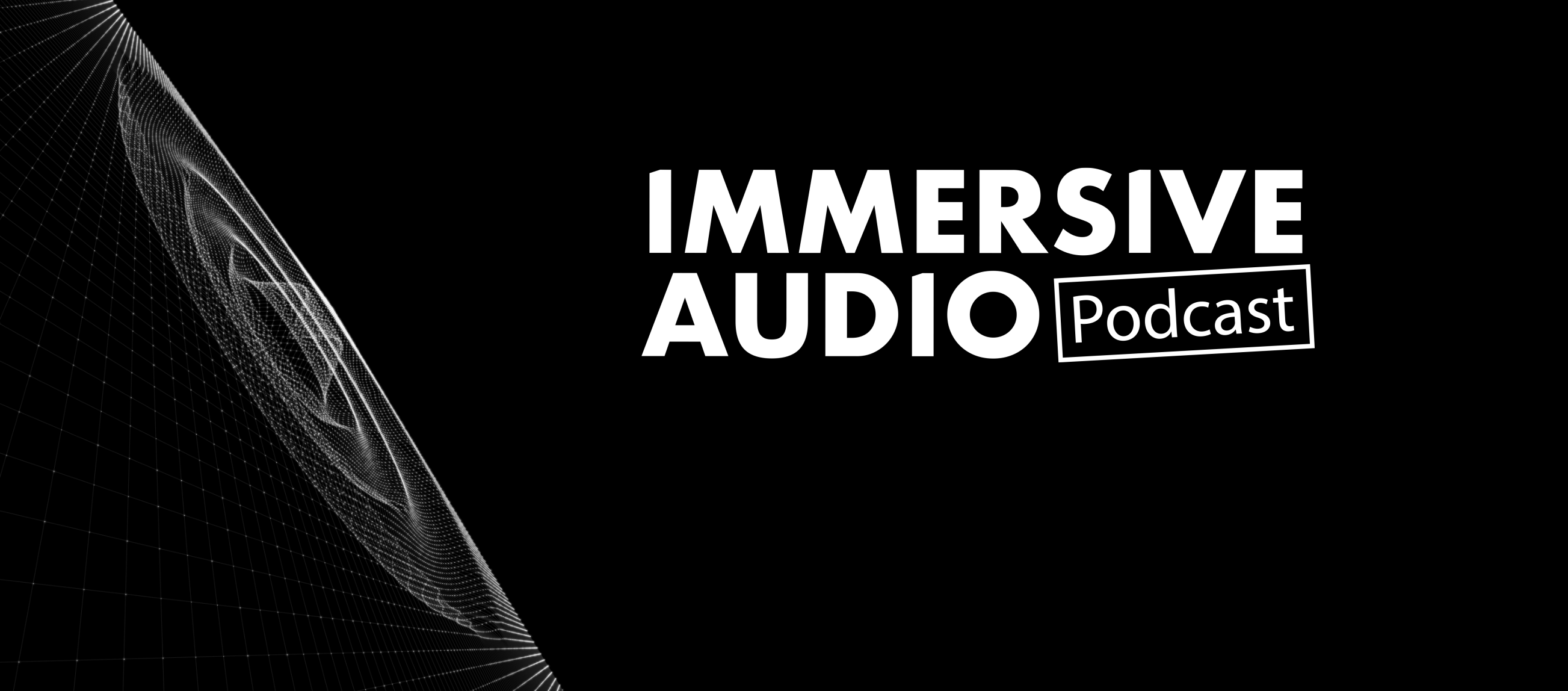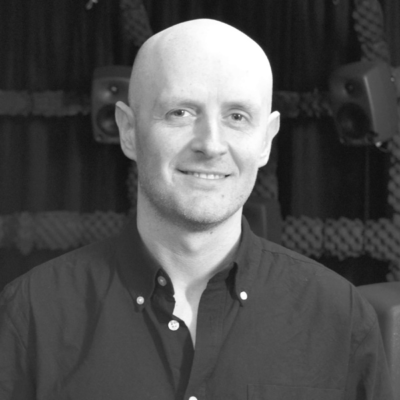Immersive Audio Podcast Episode 40 – Bruce Wiggins & Duncan Werner (University of Derby & GASP)
Summary
In this episode of the Immersive Audio Podcast, Oliver Kadel is joined by senior academics of University of Derby Dr Bruce Wiggins and Duncan Werner via Zoom from Derbyshire, UK.

Dr Bruce Wiggins graduated with a 1st class honours in Music Technology and Audio System Design from the University of Derby in 1999. His interest in audio signal processing spurred him to continue at Derby completing his PhD entitled “An Investigation into the Real-time Manipulation and Control of 3D Sound Fields” in 2004 where he solved the problem of generating Ambisonic decoders for irregular speaker arrays and looked at the optimisation of binaural/transaural systems. Bruce’s research into Ambisonics has been featured as an impact case study in the national Research Excellence Framework in 2014 and will be again in 2021. His latest work is based around the auralisation of rooms to very high order Ambisonics with head-tracking.

Duncan Werner graduated from Aston University in Electrical/Electronic Engineering in the late seventies, but as a keen musician moved towards the music industry gaining work as a recording and touring musician in the UK and Europe, subsequently being employed by the London-based Chrysalis Music Group as studio sound engineer. This was followed by postgraduate Music Technology studies at City University London. Research interests include immersive music production, in particular the GASP system (Guitars with Ambisonic Spatial Performance) based at the University of Derby. He has been programme leader for BSc Music Technology since its inception in 1995 and is currently Programme Leader for MA Music Production.
In this episode, we dive into the collaborative project GASP (Guitars with Ambisonic Spatial Performance), discuss the Sound in Space Symposium, and current research projects for immersive audio.
Listen to Podcast
Show Notes
University of Derby – https://www.derby.ac.uk/
Sound in Space – http://soundsinspace.co.uk/
Bruce Wiggins Academic Profile – http://www.derby.ac.uk/staff/bruce-wiggins
Bruce Wiggins Website – http://www.brucewiggins.co.uk/
GASP Website – Guitars with Ambisonic Spatial Performance – http://gaspproject.xyz/
GASP Paper – http://gaspproject.xyz/wp-content/uploads/2020/07/GASP-paper-for-Innovation-in-Music.pdf
VLC Player – https://www.videolan.org/vlc/index.en-GB.html
AmbiFreeverb 2 – https://www.researchgate.net/publication/289958469_AmbiFreeverb_2_WigWare_-_Sounds_in_Space_2015
https://derby.openrepository.com/handle/10545/618606
Measured Reverbs for Ambisonics and VR – https://www.brucewiggins.co.uk/?page_id=881
Webcam Head-tracked Ambisonics (WHAM) – https://brucewiggins.co.uk/WHAM
Cat Fantastic Mix 1 (comparison mix)
CatFantasticAmbiX3rdOrder: http://gaspproject.xyz/gaspaudio/CatFantasticAmbiX3rdOrder.wav
Facebook: https://www.facebook.com/111035420660669/videos/904591106728398/
HOAST: https://hoast.iem.at/play/cat_fantastic_o3
Cat Fantastic Mix 1: applies post-production timbral morphing and dynamic spatialisation. This is the first GASP binaural demo track in the podcast; the original ‘raw’ guitar is at the beginning which then morphs through timbral and spatial variations up to around 1.10 when the raw guitar returns. Performed by Jack Hooley, production by Duncan Werner and Emma Fitzmaurice. The recording has no overdubs, that is, the final production is derived from one single guitar performance. Post-production included experimenting with ‘timbral morphing’, where multiple versions of each string, each with different timbres were printed on time-synchronized parallel tracks, thus allowing crossfading between individual string timbres, then mixing together the respective tracks. The timbral morphing works well and we have now developed templates for real-time timbral morphing for live performance applications.
————————————————————————————————————–
Pale Aura (comparison mix)
PaleAuraAmbiX2ndOrderComparisonMix.wav: http://gaspproject.xyz/gaspaudio/PaleAuraAmbiX2ndOrderComparisonMix.wav
Facebook: https://www.facebook.com/GASP-Guitars-with-Ambisonic-Spatial-Performance-111035420660669/
HOAST: https://hoast.iem.at/play/pale_aura_comparison_o2
Pale Aura: performed by Dominic Dallali, production by Jack Hooley and Dominic Dallali. This is the first GASP binaural demo track in the podcast; the original ‘raw’ guitar is at the beginning which then morphs through timbral and spatial variations up to around 1.10 when the raw guitar returns. The recording has no overdubs, that is, the final production is derived from one single guitar performance. This track is the guitar part of the song Pale Aura by the band Periphery; it is in the genre of progressive metal. It turned out to be quite a dramatic production, with rapid changes in location for close temporal events. The guitar part consists of some highly syncopated timing elements, which have been mapped to rapid location switching. There is a good range of amp distortion timbres employed for different parts of the performance. A low kick drum was included to provide the listener with a sense of meter as the guitar performance which includes several syncopated elements.
————————————————————————————————————–
Prelude to Life (comparison mix)
PreludeToLifeAmbiX2ndOrderComparisonMix.wav
http://gaspproject.xyz/gaspaudio/PreludeToLifeAmbiX2ndOrderComparisonMix.wav
Facebook: https://www.facebook.com/111035420660669/videos/637100453564316/
HOAST: https://hoast.iem.at/play/prelude_to_life_comparison_o2
Prelude to Life: composed and performed by Fred T Baker, production by Charlie Box and Duncan Werner. This is the first GASP binaural demo track in the podcast; the original ‘raw’ guitar is at the beginning which then morphs through timbral and spatial variations up to around 1.10 when the raw guitar returns. The recording has no overdubs, that is, the final production is derived from one single guitar performance. Post-production timbralisation is a mix of both NI Guitar Rig and instrument samples. Melodyne’s pitch to MIDI conversion was applied, the MIDI note events were then arranged to trigger various instrument samples e.g. orchestral strings with other sampled and synthetic sounds. Upon reflection, the timing of pitch to MIDI conversion worked very well, such that the nuances of the guitar performance are precisely captured.
————————————————————————————————————–
GASP is ‘Guitars with Ambisonic Spatial Performance’. The project is the design, realisation, and application of a spatial-audio guitar production system; it is aimed towards guitarists, music producers and spatial-audio sound designers. GASP is an ongoing University of Derby research project, where our interest in Ambisonic algorithmic research and guitar sound production is combined with off-the-shelf hardware and bespoke software to create an Ambisonic based immersive guitar sound system. Applications include:
Live performance as an immersive spatial sound instrument, either as a solo instrument or as part of an ensemble, for both small or large format theatre or concert systems
Audio post-production immersive sound for on-line spatial audio applications such as YouTube and Facebook 360, including Virtual Reality applications
Guitar performance analysis and tuition tool, where on-screen displays enable identification of notation and performance artefacts which provide feedback to the player
A research tool for performative applications, with significant potential for use in the Sound Arts world
We’ve recently set up a GASP page: www.gaspproject.xyz which includes links to some of our example demo GASP productions, as well as the project timeline, posters and includes our paper ‘Development of an Ambisonic Guitar System’ which was presented to ‘Innovation in Music’ conference at the University of West London in December 2019, it’s due for publication by Routledge as a book chapter sometime in 2021. https://www.routledge.com/Innovation-in-Music-Future-Opportunities/Hepworth-Sawyer-Paterson-Toulson/p/book/9780367363352
Dring, M., Wiggins, B. (2019) The Transparency of Binaural Auralisation Using Very High Order Circular Harmonics. Reproduced Sound 2019 – Proceedings of the Institute of Acoustics, p165-173, Vol. 41. Pt. 3 2019, Bristol, UK
Wiggins, B., Dring, M., (2016) AmbiFreeVerb 2—Development of a 3D Ambisonic Reverb with Spatial Warping and Variable Scattering. 2016 AES International Conference on Sound Field Control. University of Surrey, Guildford, UK.
Wiggins, B. (2017) Measured Reverbs for Ambisonics and VR. Sounds in Space Research Symposium 2017, Derby, UK. (Video)
Survey
We want to hear from you! We really value our community and would appreciate it if you would take our very quick survey and help us make the Immersive Audio Podcast even better: surveymonkey.co.uk/r/3Y9B2MJ Thank you!
Credits
This episode was produced by Oliver Kadel and Michelle Chan with the help of Emma Rees and included music by Knobs Bergamo.




